Influence of Ni on the Microstructures and Mechanical Properties of Heat-Treated Al-Cu-Ce-Mn-Zr Alloys
Abstract
1. Introduction
2. Materials and Methods
2.1. Alloys Preparation
2.2. Heat Treatments
2.3. Microstructure Analysis
2.4. Mechanical Testing
3. Results
3.1. Microstructures of Heat-Treated Alloys
3.2. Mechanical Properties of Heat-Treated Alloys
3.3. Fracture Surfaces Characterizations
4. Discussion
5. Conclusions
Author Contributions
Funding
Institutional Review Board Statement
Informed Consent Statement
Data Availability Statement
Conflicts of Interest
References
- Zolotorevsky, V.S.; Belov, N.A. Casting Aluminum Alloys, 1st ed.; Elsevier: Oxford, UK, 2007; pp. 1–10. [Google Scholar]
- Williams, J.C.; Starke, E.A., Jr. Progress in structural materials for aerospace systems. Acta Mater. 2003, 51, 5775–5799. [Google Scholar] [CrossRef]
- Dursun, T.; Soutis, C. Recent developments in advanced aircraft aluminium alloys. Mater. Design 2014, 56, 862–871. [Google Scholar] [CrossRef]
- Roy, S.; Allard, L.F.; Rodriguez, A.; Porter, W.D.; Shyam, A. Comparative Evaluation of Cast Aluminum Alloys for Automotive Cylinder Heads: Part II-Mechanical and Thermal Properties. Metall. Mater. Trans. A 2017, 48, 2543–2562. [Google Scholar] [CrossRef]
- Manasijevic, S.; Radisa, R.; Markovic, S.; Acimovic-Pavlovic, Z.; Raic, K. Thermal analysis and microscopic characterization of the piston alloy AlSi13Cu4Ni2Mg. Intermetallics 2011, 19, 486–492. [Google Scholar] [CrossRef]
- Asghar, Z.; Requena, G.; Zahid, G.H.; Rafi-ud-Din, D. Effect of thermally stable Cu- and Mg-rich aluminides on the high temperature strength of an AlSi12CuMgNi alloy. Mater. Charact. 2014, 88, 80–85. [Google Scholar] [CrossRef]
- Sui, Y.; Wang, Q.; Liu, T.; Ye, B.; Jiang, H.; Ding, W. Influence of Gd content on microstructure and mechanical properties of cast Al-12Si-4Cu-2Ni-0.8Mg alloys. J. Alloys Compd. 2015, 644, 228–235. [Google Scholar] [CrossRef]
- Liu, H.Q.; Pang, J.C.; Wang, M.; Li, S.X.; Zhang, Z.F. Effect of temperature on the mechanical properties of Al-Si-Cu-Mg-Ni-Ce alloy. Mater. Sci. Eng. A 2021, 824, 141762. [Google Scholar] [CrossRef]
- Wang, M.; Pang, J.; Qiu, Y.; Liu, H.; Li, S.; Zhang, Z. Tensile strength evolution and damage mechanisms of Al-Si piston alloy at different temperatures. Adv. Eng. Mater. 2018, 20, 1700610. [Google Scholar] [CrossRef]
- Zuo, L.; Ye, B.; Feng, J.; Kong, X.; Jiang, H.; Ding, W. Microstructure, tensile properties and creep behavior of Al-12Si-3.5Cu-2Ni-0.8Mg alloy produced by different casting technologies. J. Mater. Sci. Technol. 2017, 34, 164–170. [Google Scholar] [CrossRef]
- Sui, Y.; Han, L.; Wang, Q. Effects of Thermal Exposure on the Microstructure and Mechanical Properties of Al-Si-Cu-Ni-Mg-Gd Alloy. J. Mater. Eng. Perform. 2019, 28, 908–915. [Google Scholar] [CrossRef]
- Dar, S.M.; Liao, H.; Xu, A. Effect of Cu and Mn content on solidification microstructure, T-phase formation and mechanical property of Al-Cu-Mn alloys. J. Alloys Compd. 2019, 774, 758–767. [Google Scholar] [CrossRef]
- Dar, S.M.; Liao, H. Creep behavior of heat resistant Al-Cu-Mn alloys strengthened by fine (θ′) and coarse (Al20Cu2Mn3) second phase particles. Mater. Sci. Eng. A 2019, 763, 38062. [Google Scholar] [CrossRef]
- Shower, P.; Roy, S.; Hawkins, C.S.; Shyam, A. The effects of microstructural stability on the compressive response of two cast aluminum alloys up to 300 °C. Mater. Sci. Eng. A 2017, 700, 519–529. [Google Scholar] [CrossRef]
- Shui, L.; Zhang, S.R.; Li, H. Study on high temperature performance of cast alloy Al-RE-Cu-Mn-Si. Foundry 2004, 53, 528–530. [Google Scholar]
- Zhang, C.B.; Wang, Z.T. Casting aluminum alloys used for aeronautic and aerospace vehicle (3). Light Alloy Fabr. Technol. 2013, 41, 1–14. [Google Scholar]
- Zhao, B.; Zhan, Y.; Tang, H. High-temperature properties and microstructural evolution of Al-Cu-Mn-RE (La/Ce) alloy designed through thermodynamic calculation. Mater. Sci. Eng. A 2019, 758, 7–18. [Google Scholar] [CrossRef]
- Chen, C.L.; Richter, A.; Thomson, R.C. Investigation of mechanical properties of intermetallic phases in multi-component Al-Si alloys using hot-stage nanoindentation. Intermetallics 2010, 18, 499–508. [Google Scholar] [CrossRef]
- Ma, X.; Zhao, Y.F.; Tian, W.J.; Qian, Z.; Chen, H.W.; Wu, Y.Y.; Liu, X.F. A novel Al matrix composite reinforced by nano-AlNp network. Sci. Rep. 2016, 6, 34919. [Google Scholar] [CrossRef]
- Asghar, Z.; Requena, G.; Boller, E. Three-dimensional rigid multiphase networks providing high-temperature strength to cast AlSi10Cu5Ni1-2 piston alloys. Acta Mater. 2011, 59, 6420–6432. [Google Scholar] [CrossRef]
- Asghar, Z.; Requena, G.; Degischer, H.P.; Cloetens, P. Three-dimensional study of Ni aluminides in an AlSi12 alloy by means of light optical and synchrotron microtomography. Acta Mater. 2009, 57, 4125–4132. [Google Scholar] [CrossRef]
- Zuo, L.; Ye, B.; Feng, J.; Xu, X.; Kong, X.; Jiang, H. Effect of δ-Al3CuNi phase and thermal exposure on microstructure and mechanical properties of Al-Si-Cu-Ni alloys. J. Alloys Compd. 2019, 791, 1015–1024. [Google Scholar] [CrossRef]
- Zamani, M.; Morini, L.; Ceschini, L.; Seifeddine, S. The role of transition metal additions on the ambient and elevated temperature properties of Al-Si alloys. Mater. Sci. Eng. A 2017, 693, 42–50. [Google Scholar] [CrossRef]
- Farkoosh, A.R.; Grant Chen, X.; Pekguleryuz, M. Dispersoid strengthening of a high temperature Al-Si-Cu-Mg alloy via Mo addition. Mater. Sci. Eng. A 2015, 620, 181–189. [Google Scholar] [CrossRef]
- Asghar, Z.; Requena, G.; Kubel, F. The role of Ni and Fe aluminides on the elevated temperature strength of an AlSi12 alloy. Mater. Sci. Eng. A 2010, 527, 5691–5698. [Google Scholar] [CrossRef]
- Shaha, S.K.; Czerwinski, F.; Kasprzak, W.; Friedman, J.; Chen, D.L. Ageing characteristics and high-temperature tensile properties of Al-Si-Cu-Mg alloys with micro-additions of Mo and Mn. Mater. Sci. Eng. A 2017, 684, 726–736. [Google Scholar] [CrossRef]
- Han, L.; Sui, Y.; Wang, Q.; Wang, K.; Jiang, Y. Effects of Nd on microstructure and mechanical properties of cast Al-Si-Cu-Ni-Mg piston alloys. J. Alloys Compd. 2017, 695, 1566–1572. [Google Scholar] [CrossRef]
- Farkoosh, A.R.; Pekguleryuz, M. The effects of manganese on the Τ-phase and creep resistance in Al-Si-Cu-Mg-Ni alloys. Mater. Sci. Eng. A 2013, 582, 248–256. [Google Scholar] [CrossRef]
- Qin, J.; Tan, P.; Quan, X.; Liu, Z.; Yi, D.; Wang, B. The effect of Sc addition on microstructure and mechanical properties of as-cast Zr-containing Al-Cu alloys. J. Alloys Compd. 2022, 909, 164686. [Google Scholar] [CrossRef]
- Li, G.J.; Guo, M.X.; Wang, Y.; Zheng, C.H.; Zhang, J.S.; Zhuang, L.Z. Effect of Ni addition on microstructure and mechanical properties of Al-Mg-Si-Cu-Zn alloys with a high Mg/Si ratio. Int. J. Min. Metall. Mater. 2019, 26, 740–751. [Google Scholar] [CrossRef]
- Zhang, L.; Zhang, S.J.; Xu, P.; Huang, H. Effects of substitution of Cu with Ni on microstructure and mechanical properties of Mg-Er-Cu alloy. J. Mater. Eng. Perform. 2022, 31, 552–559. [Google Scholar] [CrossRef]
- Zhao, R.; Zhu, W.; Zhang, J.; Zhang, L.; Zhang, J.; Xu, C. Influence of Ni and Bi microalloying on microstructure and mechanical properties of as-cast low RE LPSO-containing Mg-Zn-Y-Mn alloy. Mater. Sci. Eng. A 2020, 788, 139594. [Google Scholar] [CrossRef]
- Niu, R.; Toplosky, V.; Han, K. Cryogenic temperature properties and secondary phase characterization of CuCrZr Composites. IEEE Trans. Appl. Supercon. 2022, 32, 1–5. [Google Scholar] [CrossRef]
- Mao, P.; Xin, Y.; Han, K.; Liu, Z.; Yang, Z. Formation of long-period stacking-ordered (LPSO) structures and microhardness of as-cast Mg-4.5Zn-6Y alloy. Mater. Sci. Eng. A 2020, 777, 139019. [Google Scholar] [CrossRef]
- Meng, Y.; Yu, J.; Liu, K.; Yu, H.; Wang, H. The evolution of long-period stacking ordered phase and its effect on dynamic recrystallization in Mg-Gd-Y-Zn-Zr alloy processed by repetitive upsetting-extrusion. J. Alloys Compd. 2020, 828, 154454. [Google Scholar] [CrossRef]
- Feng, J.; Ye, B.; Zuo, L.; Qi, R.; Wang, Q.; Jiang, H.; Huang, R.; Ding, W. Effects of Ni content on low cycle fatigue and mechanical properties of Al-12Si-0.9Cu-0.8Mg-xNi at 350 °C. Mater. Sci. Eng. A 2017, 706, 27–37. [Google Scholar] [CrossRef]
- Tiwary, C.S.; Kashyap, S.; Chattopadhyay, K. Development of alloys with high strength at elevated temperatures by tuning the bimodal microstructure in the Al-Cu-Ni eutectic system. Scripta Mater. 2014, 93, 20–23. [Google Scholar] [CrossRef]
- Zuo, L.; Ye, B.; Feng, J.; Zhang, H.; Kong, X.; Jiang, H. Effect of ε-Al3Ni phase on mechanical properties of Al-Si-Cu-Mg-Ni alloys at elevated temperature. Mater. Sci. Eng. A 2020, 772, 138794. [Google Scholar] [CrossRef]
- de Moura, D.A.; de Gouveia, G.L.; Gomes, L.F.; Spinelli, J.E. Understanding the effect of Ni content on microstructures and tensile properties of AlSi10Mg alloy samples under a variety of solidification rates. J. Alloys Compd. 2022, 924, 166496. [Google Scholar] [CrossRef]
- Li, Y.; Yang, Y.; Wu, Y.; Wang, L.; Liu, X. Quantitative comparison of three Ni-containing phases to the elevated-temperature properties of Al-Si piston alloys. Mater. Sci. Eng. A 2010, 527, 7132–7137. [Google Scholar] [CrossRef]
- Yang, Y.; Yu, K.; Li, Y.; Zhao, D.; Liu, X. Evolution of nickel-rich phases in Al-Si-Cu-Ni-Mg piston alloys with different Cu additions. Mater. Design 2012, 33, 220–225. [Google Scholar] [CrossRef]
- Belov, N.A.; Eskin, D.G.; Avxentieva, N.N. Constituent phase diagrams of the Al-Cu-Fe-Mg-Ni-Si system and their application to the analysis of aluminum piston alloys. Acta Mater. 2005, 53, 4709–4722. [Google Scholar] [CrossRef]
- Fernández-Gutiérrez, R.; Requena, G.C. The effect of spheroidization heat treatment on the creep resistance of a cast AlSi12CuMgNi piston alloy. Mater. Sci. Eng. A 2014, 598, 147–153. [Google Scholar] [CrossRef]
- Wang, W.T.; Zhang, X.M.; Gao, Z.G.; Jia, Y.Z.; Ye, L.Y.; Zheng, D.W.; Ling, L. Influences of Ce addition on the microstructures and mechanical properties of 2519A aluminum alloy plate. J. Alloys Compd. 2010, 491, 366–371. [Google Scholar] [CrossRef]
- Du, J.; Ding, D.; Zhou, X.; Zhang, J.; Tang, J. Effect of CeLa addition on the microstructures and mechanical properties of Al-Cu-Mn-Mg-Fe alloy. Mater. Charact. 2017, 123, 42–50. [Google Scholar] [CrossRef]
- Chen, Z.; Chen, P.; Li, S. Effect of Ce addition on microstructure of Al20Cu2Mn3 twin phase in an Al-Cu-Mn casting alloy. Mater. Sci. Eng. A 2012, 532, 606–609. [Google Scholar] [CrossRef]
- Khvan, A.V.; Belov, N.A. The ternary Al-Ce-Cu phase diagram in the aluminum-rich corner. Acta Mater. 2007, 55, 5473–5482. [Google Scholar]
- Sun, T.; Geng, J.; Bian, Z.; Wu, Y.; Wang, M.; Chen, D.; Ma, N.; Wang, H. Enhanced thermal stability and mechanical properties of high-temperature resistant Al-Cu alloy with Zr and Mn micro-alloying. Trans. Nonferr. Metal. Soc. 2022, 32, 64–78. [Google Scholar] [CrossRef]
- Gao, Y.H.; Yang, C.; Zhang, J.Y.; Cao, L.F.; Ma, E. Stabilizing nanoprecipitates in Al-Cu alloys for creep resistance at 300 °C. Mater. Res. Lett. 2019, 7, 18–25. [Google Scholar] [CrossRef]
- Bugelnig, K.; Sket, F.; Germann, H.; Steffens, T.; Koos, R.; Wilde, F.; Boller, E.; Requena, G. Influence of 3D connectivity of rigid phases on damage evolution during tensile deformation of an AlSi12Cu4Ni2 piston alloy. Mater. Sci. Eng. A 2018, 709, 193–202. [Google Scholar] [CrossRef]
- Chen, G.; Peng, Y.B.; Zheng, G.; Qi, Z.X.; Wang, M.Z.; Yu, H.C.; Dong, C.L.; Liu, C.T. Polysynthetic twinned TiAl single crystals for high-temperature applications. Nat. Mater. 2016, 15, 876–881. [Google Scholar] [CrossRef]
- Rodrigues, A.V.; Lima, T.S.; Vida, T.A.; Brito, C.; Garcia, A.; Cheung, N. Microstructure features and mechanical/electrochemical behavior of directionally solidified Al-6wt.%Cu-5wt.%Ni alloy. Trans. Nonferrous Met. Soc. China 2021, 31, 1529–1549. [Google Scholar] [CrossRef]
- Liao, H.; Li, G.; Liu, Q. Ni-Rich Phases in Al-12%Si-4%Cu-1.2%Mn-x%Ni Heat-Resistant Alloys and Effect of Ni-Alloying on Tensile Mechanical Properties. J. Mater. Eng. Perform. 2019, 28, 5398–5408. [Google Scholar] [CrossRef]
- Wang, S.C.; Li, C.Z.; Yan, M.G. Determination of structure of Al20Cu2Mn3 phase in Al-Cu-Mn alloys. Mater. Res. Bull. 1989, 24, 1267–1270. [Google Scholar]
- Shen, Z.; Liu, C.; Ding, Q.; Wang, S.; Wei, X.; Chen, L.; Li, J.; Zhang, Z. The structure determination of Al20Cu2Mn3 by near atomic resolution chemical mapping. J. Alloys Compd. 2014, 601, 25–30. [Google Scholar] [CrossRef]
- Chen, J.; Liao, H.; Wu, Y.; Li, H. Contributions to high temperature strengthening from three types of heat-resistant phases formed during solidification, solution treatment and ageing treatment of Al-Cu-Mn-Ni alloys respectively. Mater. Sci. Eng. A 2020, 772, 138819. [Google Scholar] [CrossRef]
- Mohamed, A.M.A.; Samuel, F.H.; Kahtani, S.A. Microstructure, tensile properties and fracture behavior of high temperature Al-Si-Mg-Cu cast alloys. Mater. Sci. Eng. A 2013, 577, 64–72. [Google Scholar] [CrossRef]
- Shyam, A.; Roy, S.; Shin, D.; Poplawsky, J.D.; Allard, L.F.; Yamamoto, Y.; Morris, J.R.; Mazumder, B.; Idrobo, J.C.; Rodriguez, A.; et al. Elevated temperature microstructural stability in cast AlCuMnZr alloys through solute segregation. Mater. Sci. Eng. A 2019, 765, 138279. [Google Scholar] [CrossRef]
- Bruska, M.; Lichy, P.; Cagala, M. Influence of remelting repeated on the mechanical properties and structure of alloys RR. 350. Metal 2012, 5, 23–25. [Google Scholar]
- Martin, M.L.; Fenske, J.A.; Liu, G.S.; Sofronis, P.; Robertson, I.M. On the formation and nature of quasi-cleavage fracture surfaces in hydrogen embrittled steels. Acta Mater. 2011, 59, 1601–1606. [Google Scholar] [CrossRef]
- Farkoosh, A.R.; Javidani, M.; Hoseini, M.; Larouche, D.; Pekguleryuz, M. Phase formation in as-solidified and heat-treated Al-Si-Cu-Mg-Ni alloys: Thermodynamic assessment and experimental investigation for alloy design. J. Alloys Compd. 2013, 551, 596–606. [Google Scholar] [CrossRef]
- Hafez, H.A.; Farag, M.M. Effect of structure on the Young’s modulus of Al-Cu-Ni alloys. J. Mater. Sci. 1981, 16, 1223–1232. [Google Scholar] [CrossRef]
- Eskin, D.G.; Toropova, L.S. Tensile and elastic properties of deformed heterogeneous aluminium-alloys at room and elevated-temperatures. Mater. Sci. Eng. A 1994, 183, 1–4. [Google Scholar] [CrossRef]
- Gao, Y.H.; Cao, L.F.; Yang, C.; Zhang, J.Y.; Liu, G.; Sun, J. Co-stabilization of θ′-Al2Cu and Al3Sc precipitates in Sc-microalloyed Al-Cu alloy with enhanced creep resistance, Mater. Today Nano 2019, 6, 100035. [Google Scholar] [CrossRef]
- Belov, N.A.; Alabin, A.N.; Matveeva, I.A. Optimization of phase composition of Al-Cu-Mn-Zr-Sc alloys for rolled products without requirement for solution treatment and quenching. J. Alloys Compd. 2014, 583, 206–213. [Google Scholar] [CrossRef]
- Sun, W.C.; Zhang, S.R.; Hou, A.Q. The Behavior of Rare Earth in Aluminum Alloys, 1st ed.; The Publishing House of Ordnance Industry: Beijing, China, 1992; p. 298. [Google Scholar]
- Mondolfo, L.F. Aluminum Alloys: Structure and Properties, 1st ed.; Butterworths: London, UK, 1976; pp. 253–629. [Google Scholar]
- Liao, H.; Tang, Y.; Suo, X.; Li, G.; Hu, Y.; Dixit, U.S.; Petrov, P. Dispersoid particles precipitated during the solutionizing course of Al-12wt%Si-4wt%Cu-1.2wt%Mn alloy and their influence on high temperature strength. Mater. Sci. Eng. A 2017, 699, 201–209. [Google Scholar] [CrossRef]
- Shaha, S.K.; Czerwinski, F.; Kasprzak, W.; Friedman, J.; Chen, D.L. Effect of Mn and heat treatment on improvements in static strength and low-cycle fatigue life of an Al-Si-Cu-Mg alloy. Mater. Sci. Eng. A 2016, 657, 441–452. [Google Scholar] [CrossRef]
- Vlach, M.; Čížek, J.; Smola, B.; Melikhova, O.; Vlček, M.; Kodetová, V.; Hruška, P. Heat treatment and age hardening of Al-Si-Mg-Mn commercial alloy with addition of Sc and Zr. Mater. Charact. 2017, 129, 1–8. [Google Scholar] [CrossRef]
- Hu, K.; Xu, Q.; Ma, X.; Sun, Q.; Gao, T.; Liu, X. A novel heat-resistant Al-Si-Cu-Ni-Mg base material synergistically strengthened by Ni-rich intermetallics and nano-AlNp microskeletons. J. Mater. Sci. Technol. 2019, 35, 306–312. [Google Scholar] [CrossRef]
- Liu, H.; Pang, J.; Wang, M.; Li, S.; Zhang, Z. The effect of thermal exposure on the microstructure and mechanical properties of multiphase AlSi12Cu4MgNi2 alloy. Mater. Charact. 2020, 159, 110032. [Google Scholar] [CrossRef]
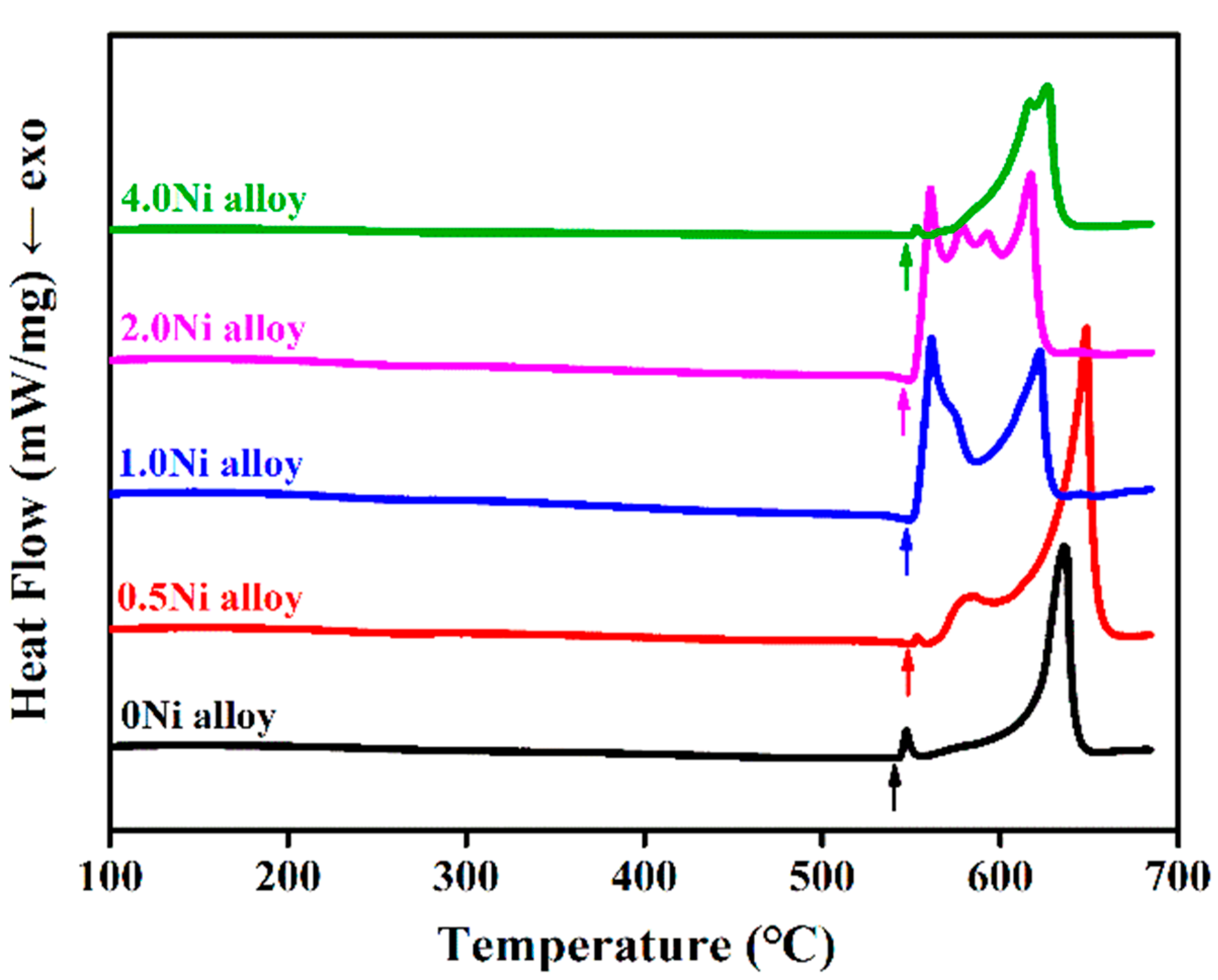
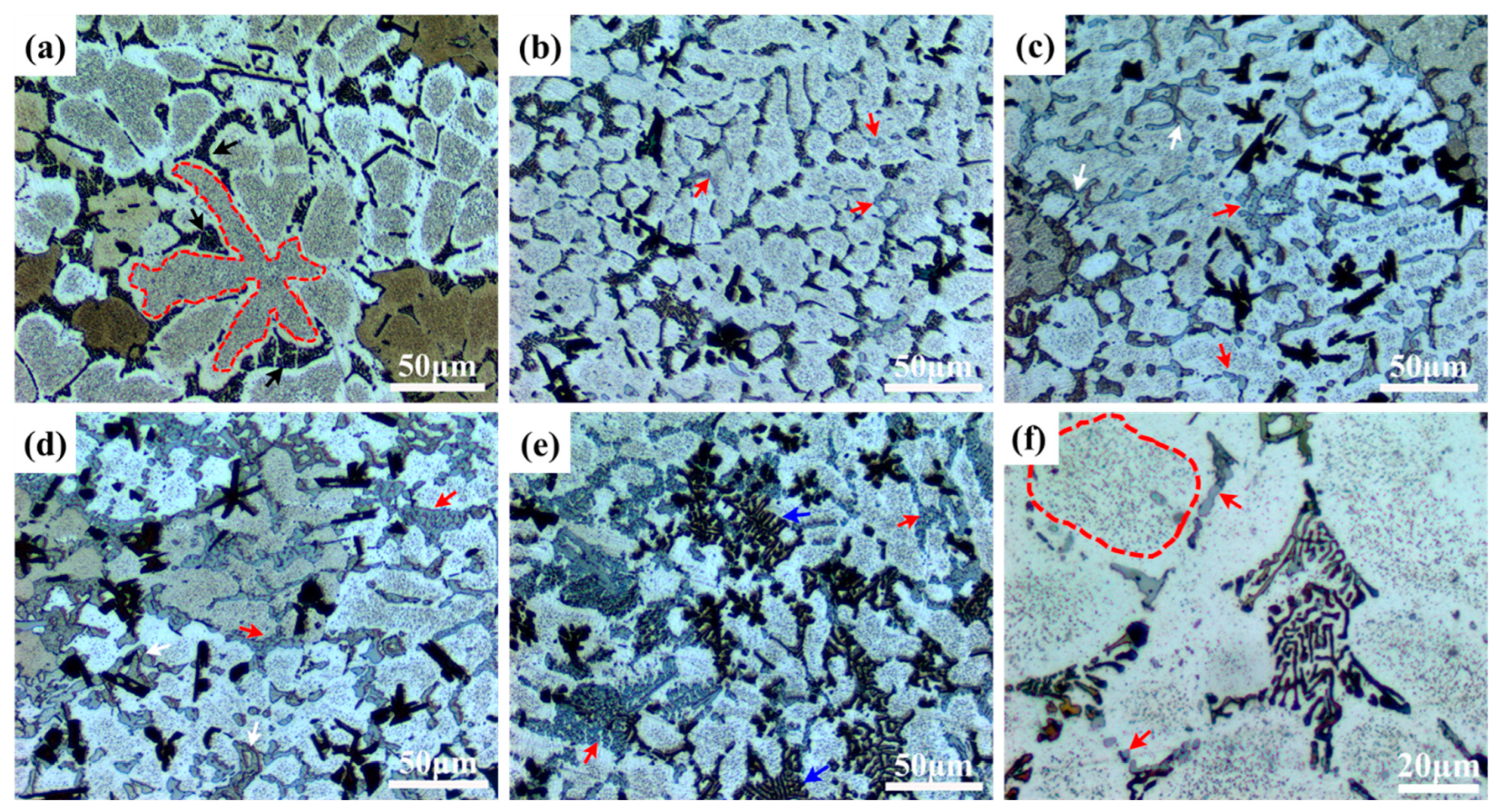
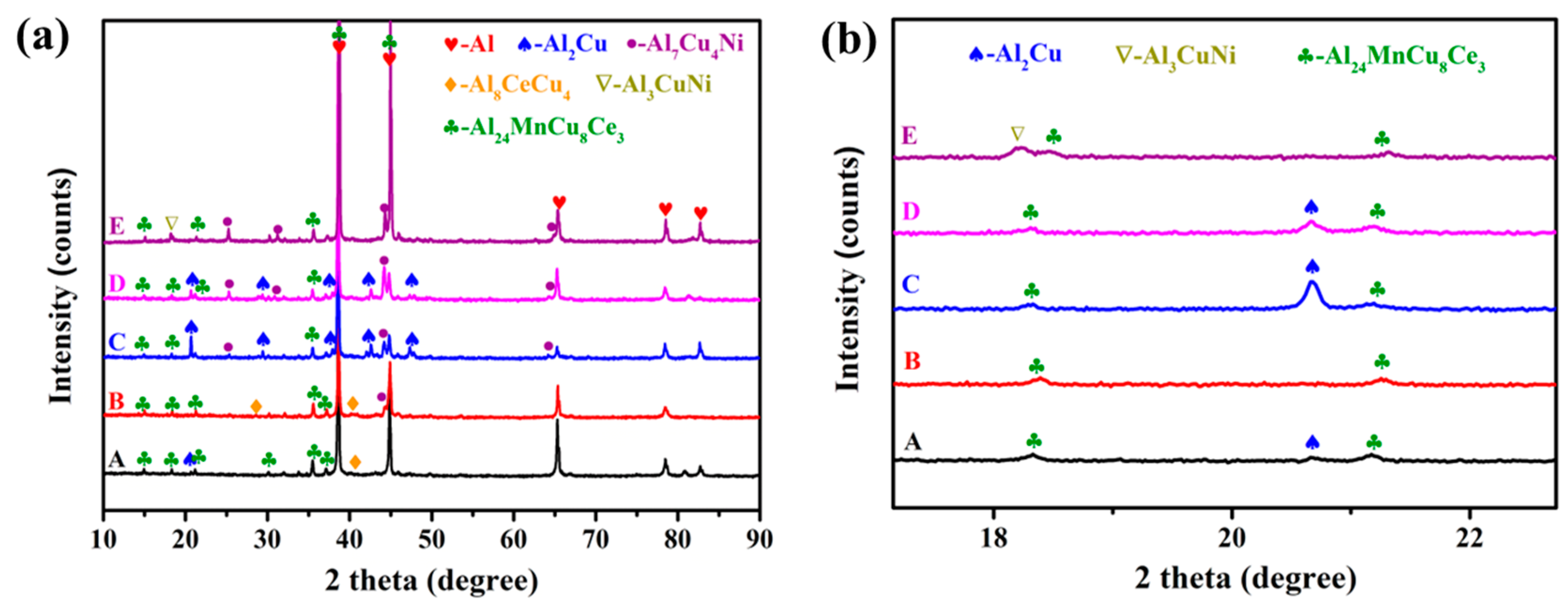
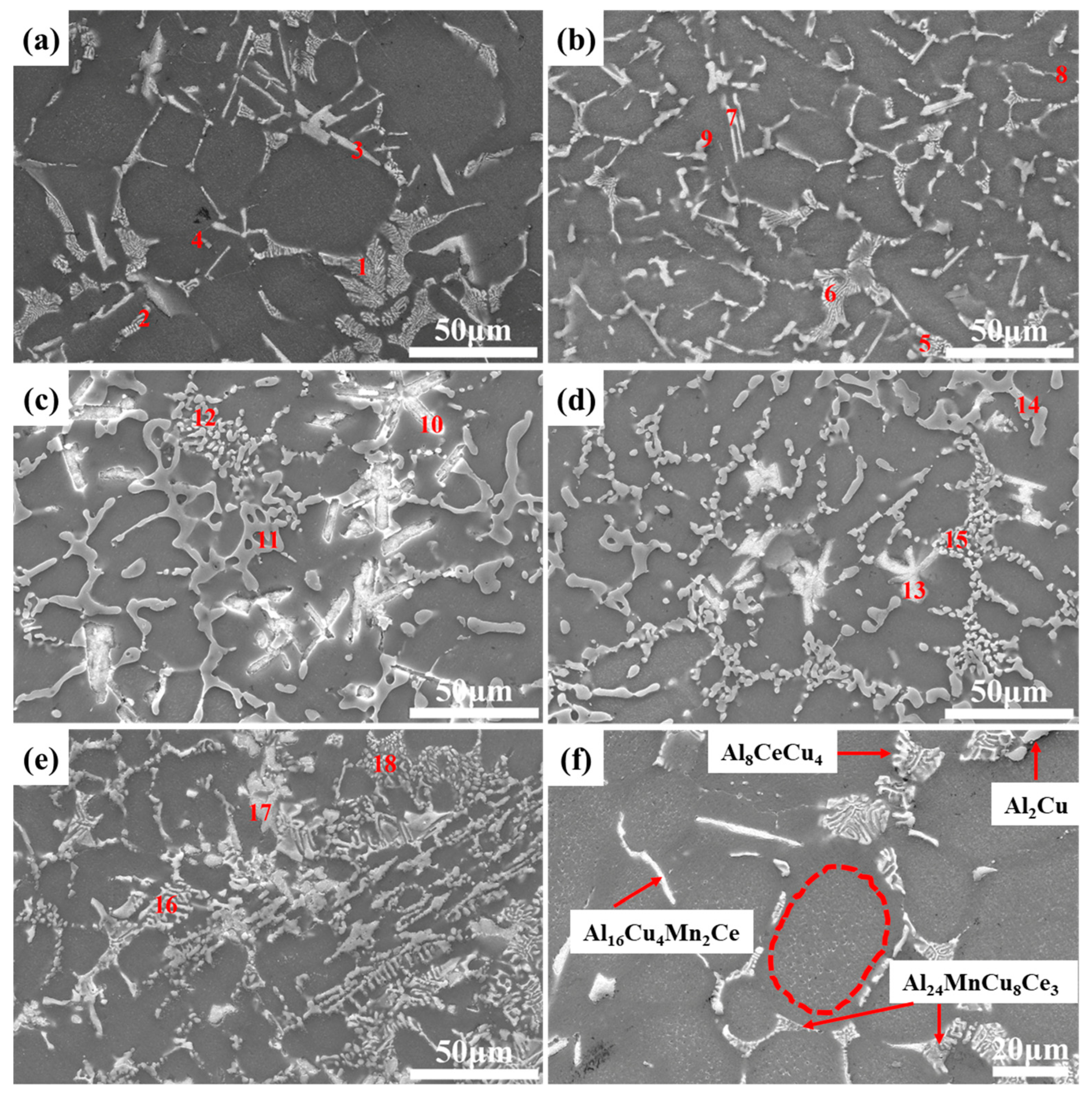
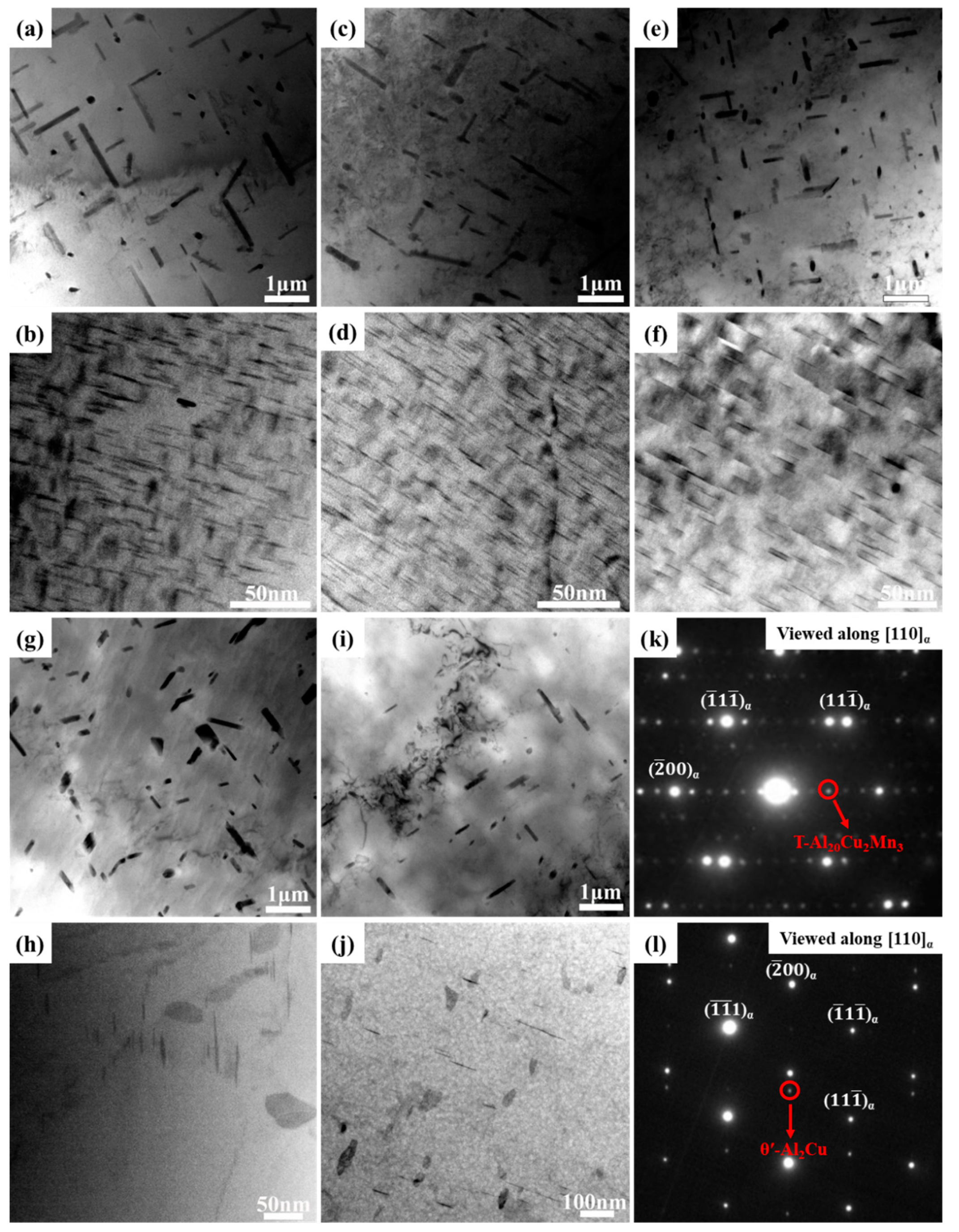
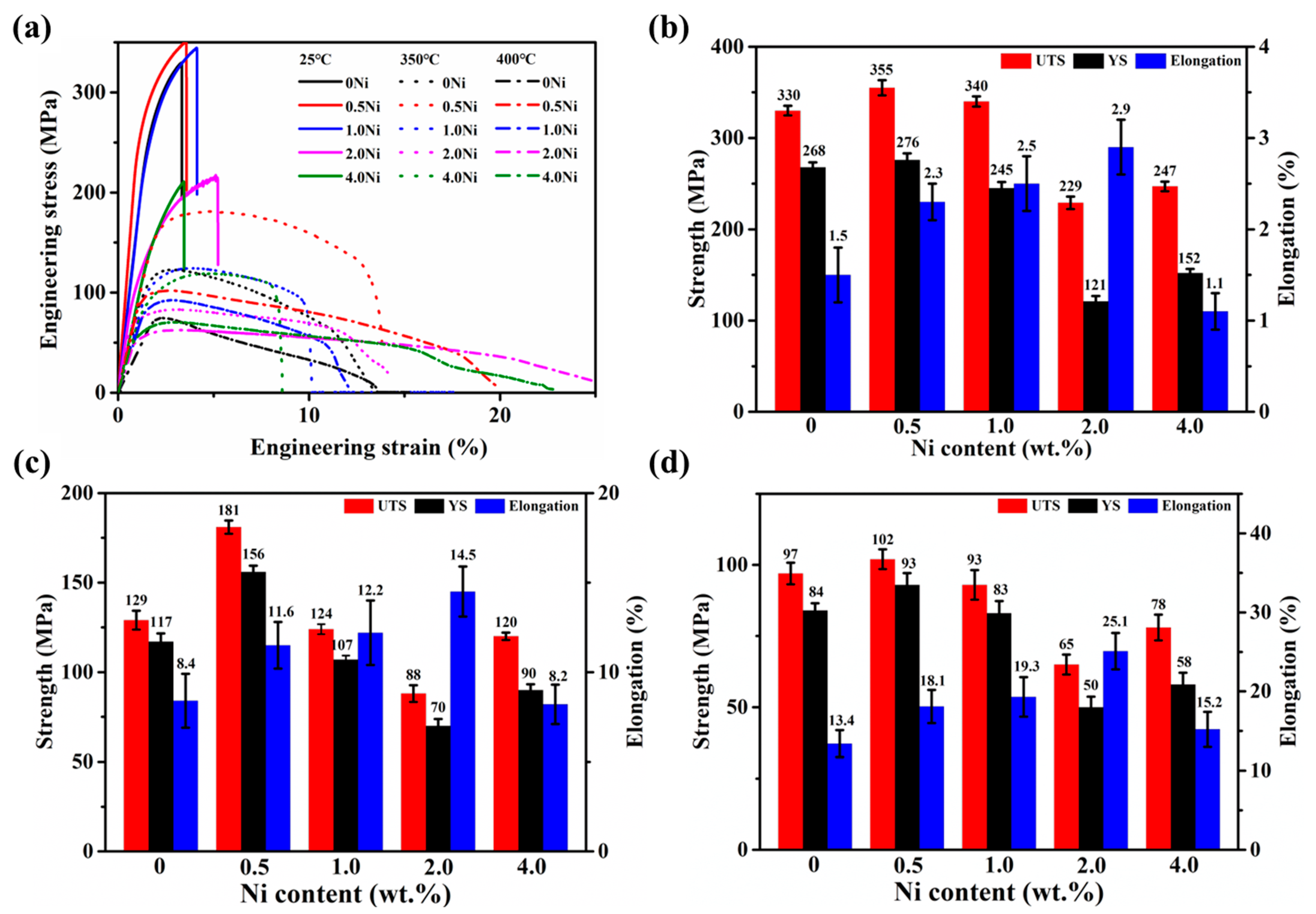

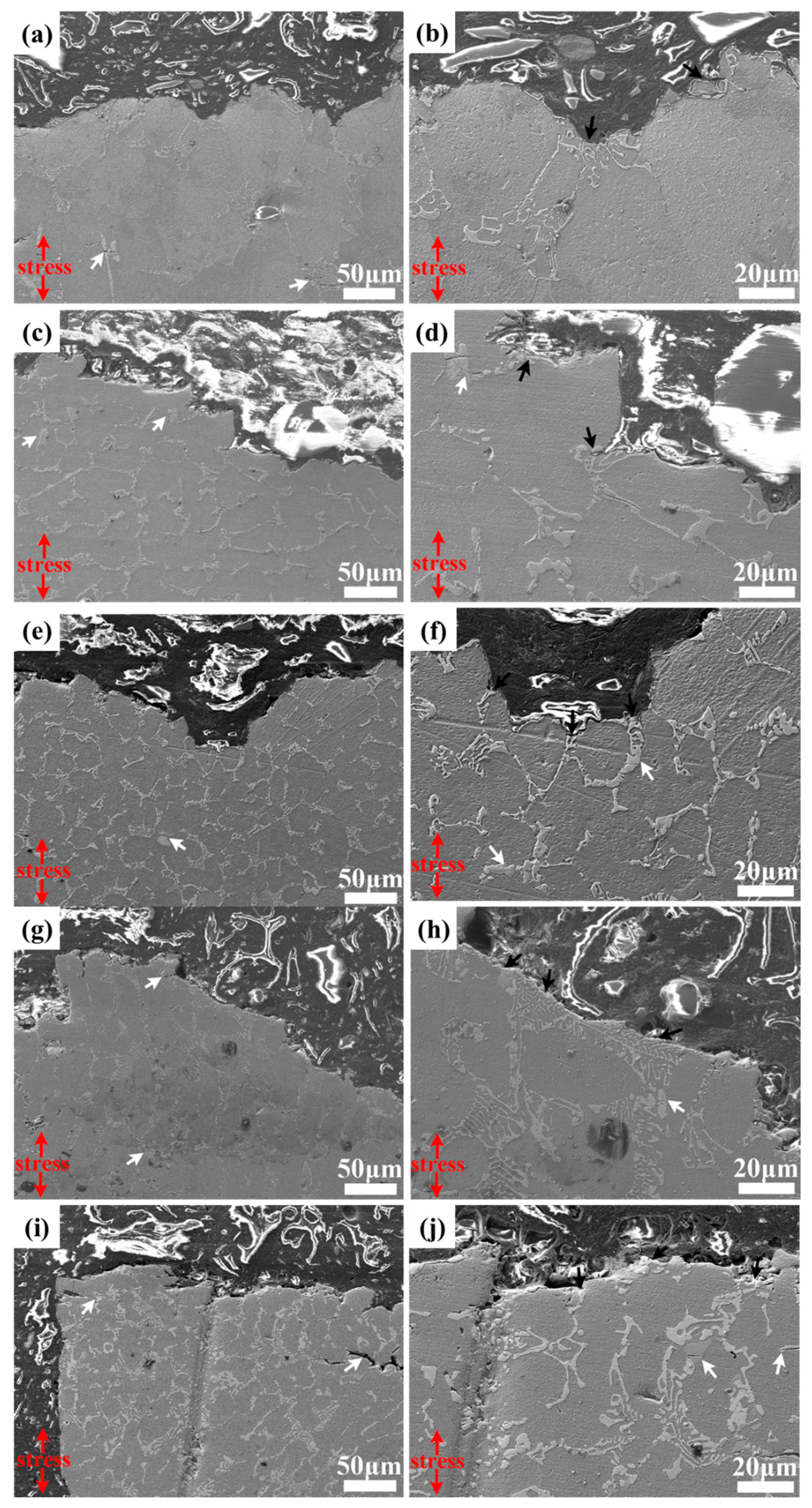
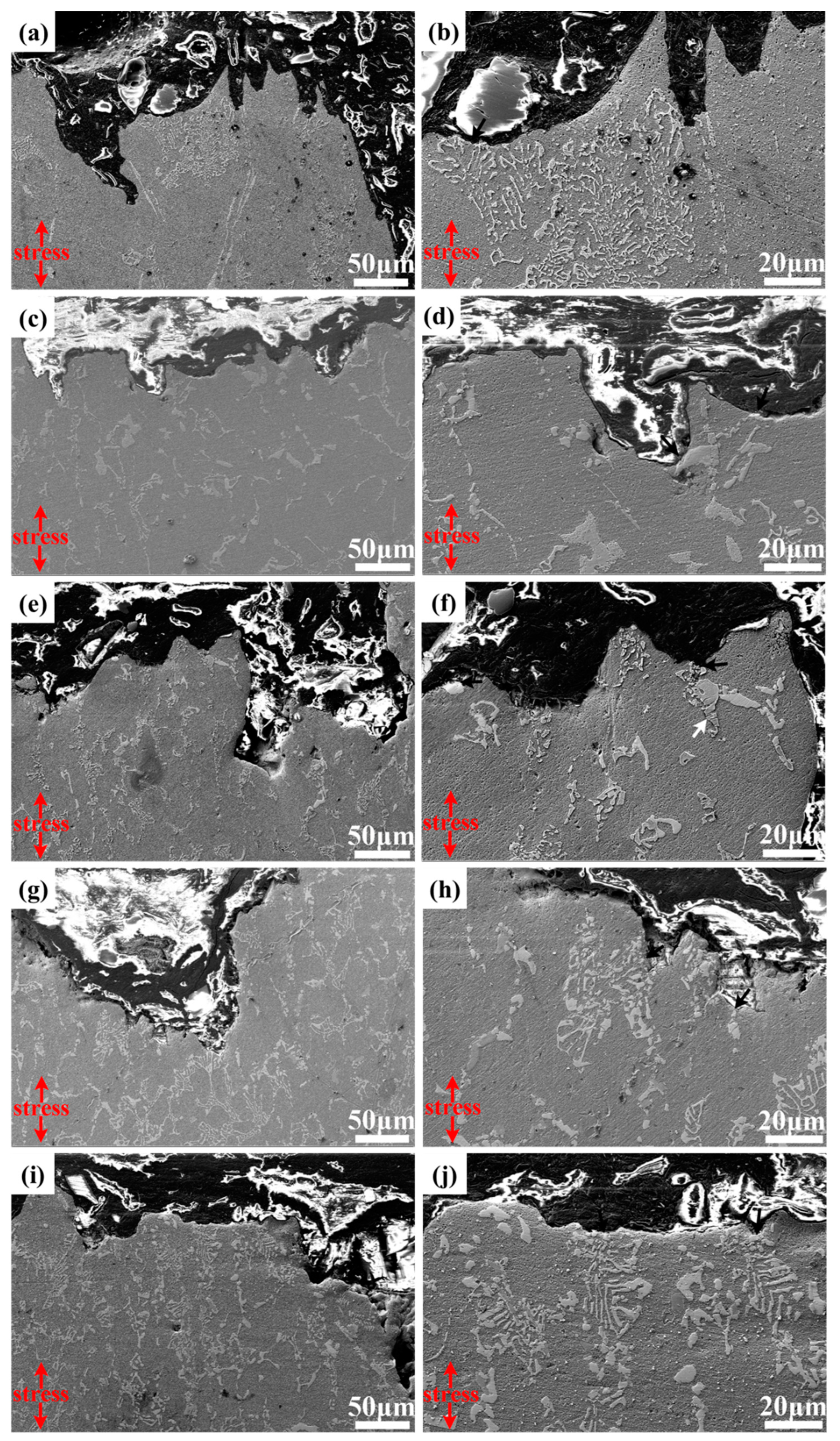
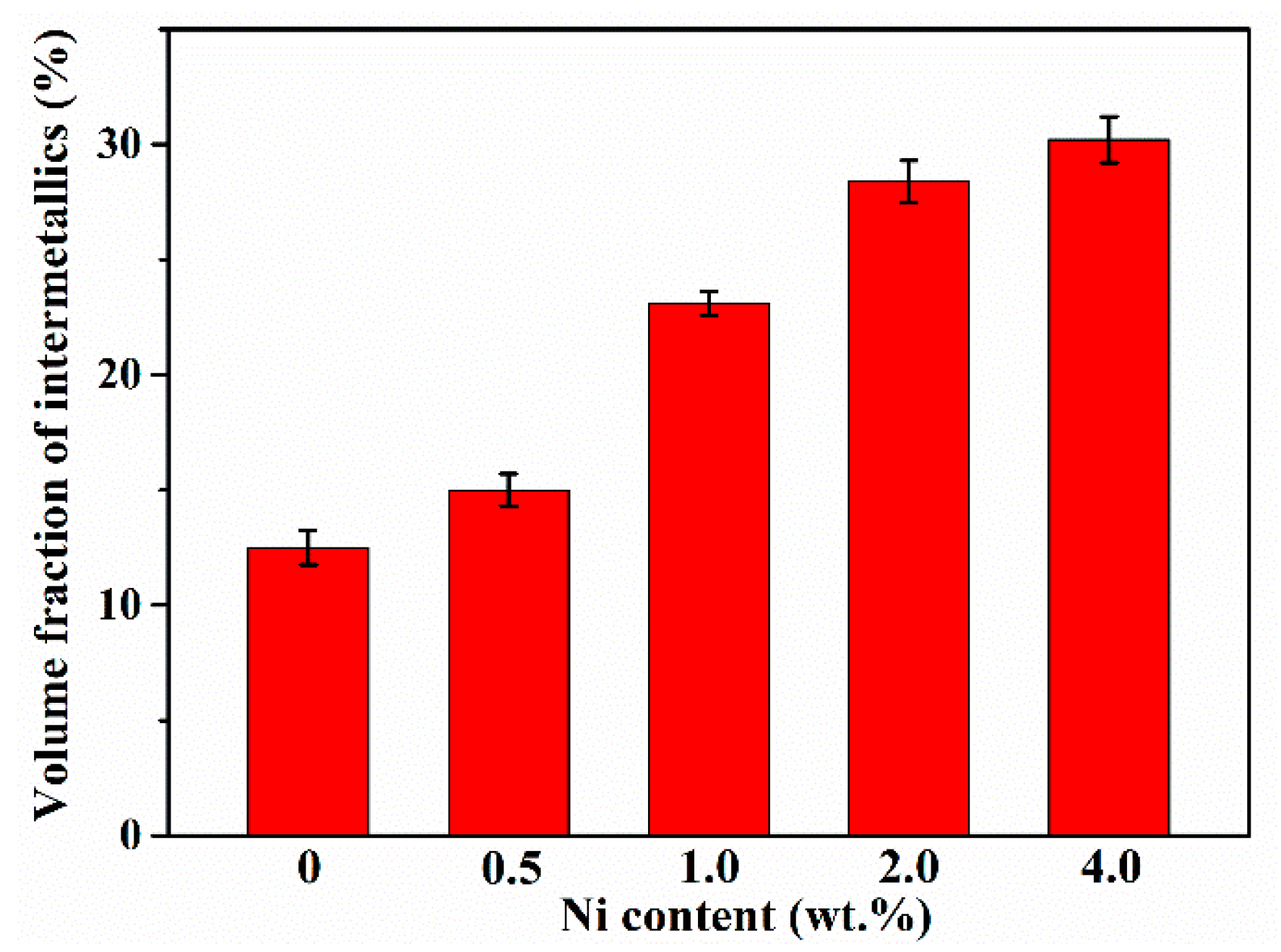
| Alloys | Cu | Ce | Mn | Ni | Zr | Al |
|---|---|---|---|---|---|---|
| 0 Ni | 8.46 | 2.29 | 0.98 | 0 | 0.21 | Bal. |
| 0.5 Ni | 8.53 | 2.33 | 1.03 | 0.48 | 0.17 | Bal. |
| 1.0 Ni | 8.45 | 2.27 | 1.02 | 1.06 | 0.22 | Bal. |
| 2.0 Ni | 8.49 | 2.22 | 1.05 | 1.91 | 0.19 | Bal. |
| 4.0 Ni | 8.34 | 2.31 | 0.96 | 3.95 | 0.18 | Bal. |
| Alloys | Solution Treatment | Quenching Treatment | Aging Treatment |
|---|---|---|---|
| 0 Ni | 535 °C/12 h | 50 °C water | 175 °C/5 h + air cooling |
| 0.5 Ni | 540 °C/12 h | ||
| 1.0 Ni | |||
| 2.0 Ni | |||
| 4.0 Ni |
| Position | Elements (at.%) | Possible Phase | |||||
|---|---|---|---|---|---|---|---|
| Al | Cu | Mn | Ce | Ni | Zr | ||
| 1 | 76.1 | 17.9 | 1.2 | 4.7 | 0 | 0.1 | Al24MnCu8Ce3 |
| 2 | 88.4 | 9.1 | 0.2 | 2.3 | 0 | 0 | Al8CeCu4 |
| 3 | 81.0 | 12.0 | 4.5 | 2.4 | 0 | 0.1 | Al16Cu4Mn2Ce |
| 4 | 73.4 | 26.2 | 0.3 | 0.1 | 0 | 0.1 | Al2Cu |
| 5 | 86.7 | 10.4 | 0.6 | 2.3 | 0 | 0 | Al24MnCu8Ce3 |
| 6 | 88.1 | 9.2 | 0.3 | 2.1 | 0.3 | 0 | Al8CeCu4 |
| 7 | 62.5 | 22.1 | 9.4 | 5.6 | 0.4 | 0 | Al16Cu4Mn2Ce |
| 8 | 71.3 | 28.3 | 0.2 | 0.1 | 0 | 0.1 | Al2Cu |
| 9 | 84.0 | 12.0 | 0 | 0 | 4.0 | 0 | Al7Cu4Ni |
| 10 | 81.7 | 10.6 | 4.7 | 2.6 | 0.4 | 0 | Al16Cu4Mn2Ce |
| 11 | 84.9 | 14.7 | 0 | 0 | 0.4 | 0 | Al2Cu |
| 12 | 71.1 | 23.1 | 0.5 | 0.7 | 4.6 | 0 | Al7Cu4Ni |
| 13 | 70.7 | 16.8 | 8.4 | 4.1 | 0 | 0 | Al16Cu4Mn2Ce |
| 14 | 87.5 | 12.1 | 0.1 | 0.1 | 0.2 | 0 | Al2Cu |
| 15 | 89.3 | 8.3 | 0 | 0 | 2.4 | 0 | Al7Cu4Ni |
| 16 | 90.8 | 1.6 | 0.8 | 0 | 6.8 | 0 | Al3CuNi |
| 17 | 73.7 | 16.2 | 6.4 | 3.3 | 0.3 | 0.1 | Al16Cu4Mn2Ce |
| 18 | 89.7 | 6.7 | 0.2 | 0.5 | 2.8 | 0.1 | Al7Cu4Ni |
| Phase | Composition (weight Percent) | Crystal Structure | Thermal Stable Temperature (°C) | Young’s Modulus (GPa) |
|---|---|---|---|---|
| Al | 100 Al | Cubic | 150–200 | 76 |
| Al2Cu | 52.5–53.9 Cu | Tetragonal | ~225 | 108 |
| Al20Cu2Mn3 | 12.8–19 Cu, 19.8–24 Mn | Orthorhombic | ~350 | -- |
| Al8CeCu4 | 19.2 Ce, 42.5 Cu | Tetragonal | 350–400 | -- |
| Al24MnCu8Ce3 | 25.8 Ce, 30.9 Cu, 3.4 Mn | Cubic | 350–400 | -- |
| Al16Cu4Mn2Ce | 15.0 Ce, 27.2 Cu, 11.7 Mn | -- | 350–400 | -- |
| Al7Cu4Ni | 38.7–50.7 Cu, 11.8–22.2 Ni | Rhombohedral | 350–400 | 163 |
| Al3CuNi | 31.2 Cu, 29.9 Ni | Hexagonal | 350–400 | 180 |
| Phase | Volume Fraction (%) |
|---|---|
| Al8CeCu4 + Al24MnCu8Ce3 | 6.7 |
| Al7Cu4Ni | 3.2 |
| Al16Cu8Mn2Ce | 4.3 |
| Al2Cu | 0.8 |
| Total | 15.0 |
Disclaimer/Publisher’s Note: The statements, opinions and data contained in all publications are solely those of the individual author(s) and contributor(s) and not of MDPI and/or the editor(s). MDPI and/or the editor(s) disclaim responsibility for any injury to people or property resulting from any ideas, methods, instructions or products referred to in the content. |
© 2023 by the authors. Licensee MDPI, Basel, Switzerland. This article is an open access article distributed under the terms and conditions of the Creative Commons Attribution (CC BY) license (https://creativecommons.org/licenses/by/4.0/).
Share and Cite
Su, X.; Qu, H.; Lei, Y.; Hou, R.; Cao, Y.; Siddique, S.; Qi, Z.; Shen, G.; Fan, X. Influence of Ni on the Microstructures and Mechanical Properties of Heat-Treated Al-Cu-Ce-Mn-Zr Alloys. Crystals 2023, 13, 380. https://doi.org/10.3390/cryst13030380
Su X, Qu H, Lei Y, Hou R, Cao Y, Siddique S, Qi Z, Shen G, Fan X. Influence of Ni on the Microstructures and Mechanical Properties of Heat-Treated Al-Cu-Ce-Mn-Zr Alloys. Crystals. 2023; 13(3):380. https://doi.org/10.3390/cryst13030380
Chicago/Turabian StyleSu, Xiang, Hongjie Qu, Yuan Lei, Rui Hou, Yuede Cao, Suniya Siddique, Zhixiang Qi, Guoyan Shen, and Xueyi Fan. 2023. "Influence of Ni on the Microstructures and Mechanical Properties of Heat-Treated Al-Cu-Ce-Mn-Zr Alloys" Crystals 13, no. 3: 380. https://doi.org/10.3390/cryst13030380
APA StyleSu, X., Qu, H., Lei, Y., Hou, R., Cao, Y., Siddique, S., Qi, Z., Shen, G., & Fan, X. (2023). Influence of Ni on the Microstructures and Mechanical Properties of Heat-Treated Al-Cu-Ce-Mn-Zr Alloys. Crystals, 13(3), 380. https://doi.org/10.3390/cryst13030380






